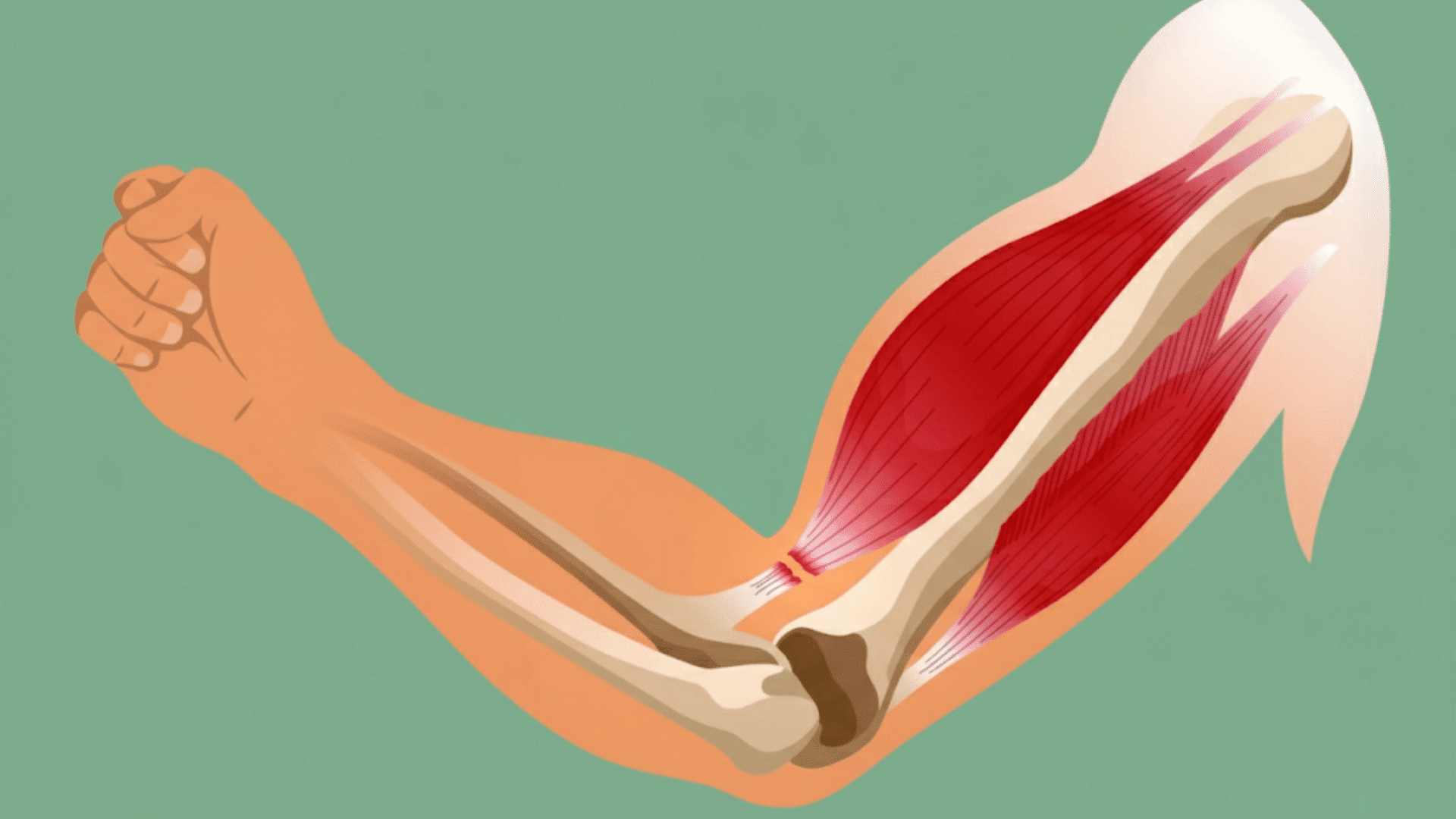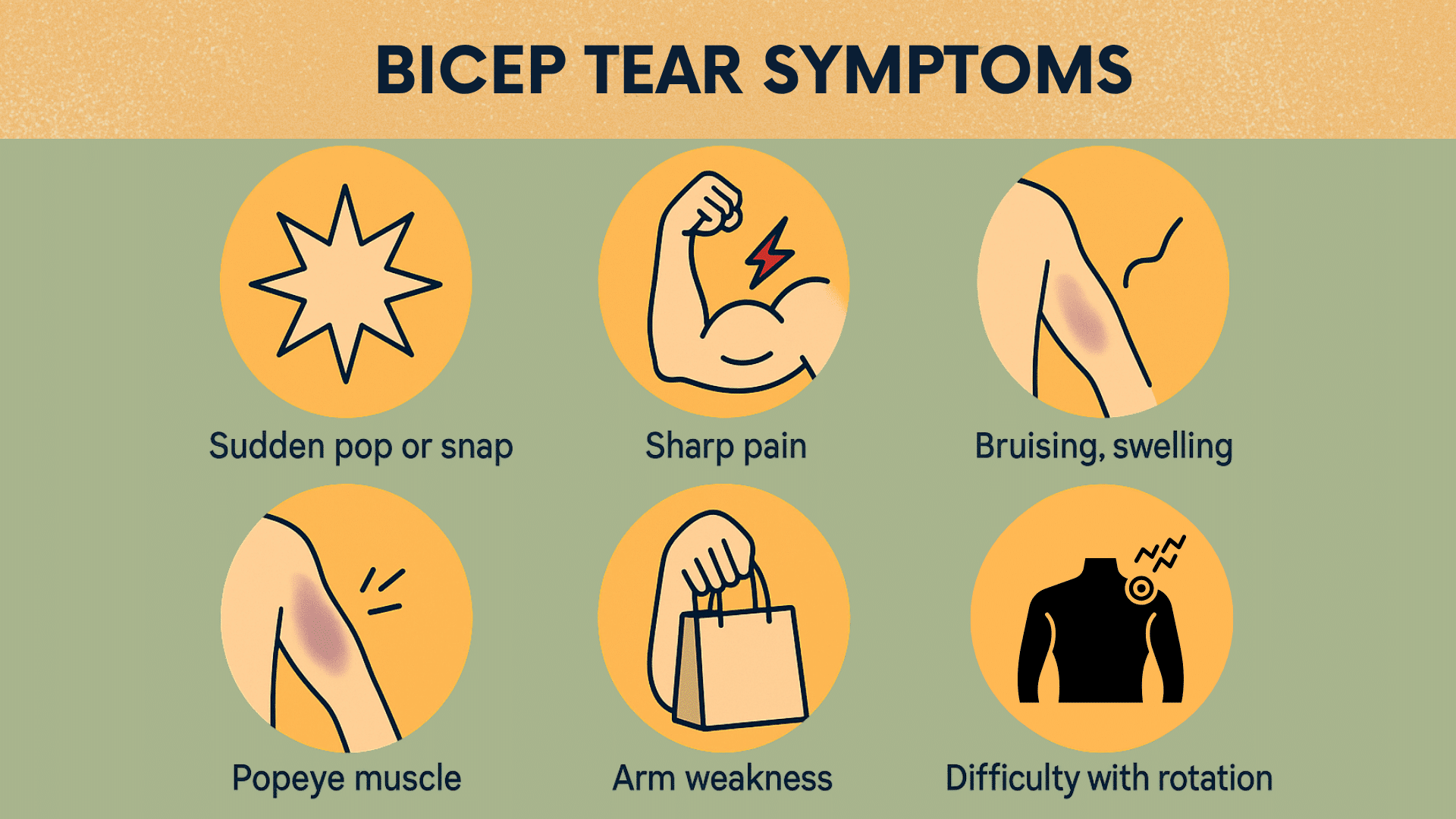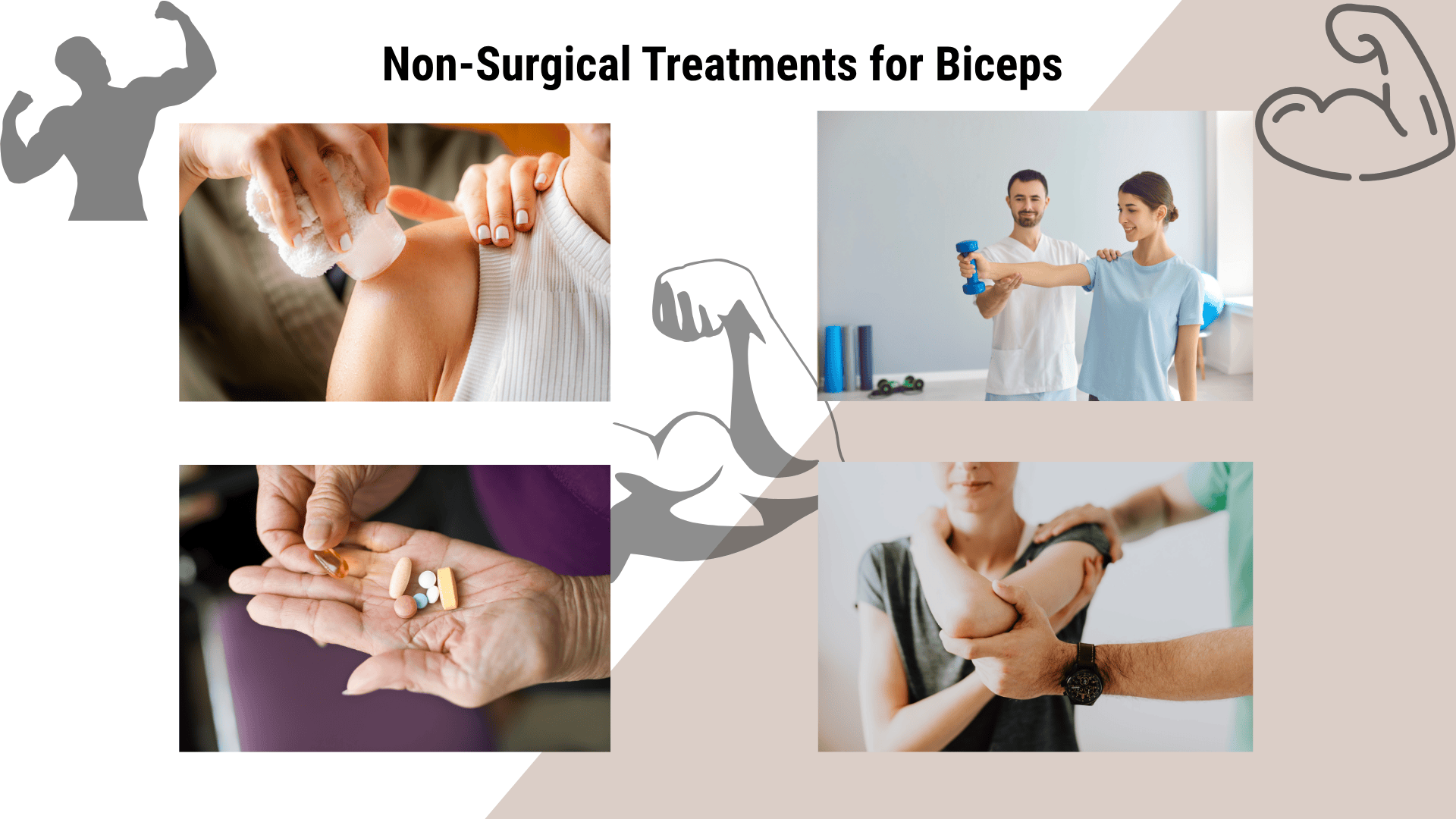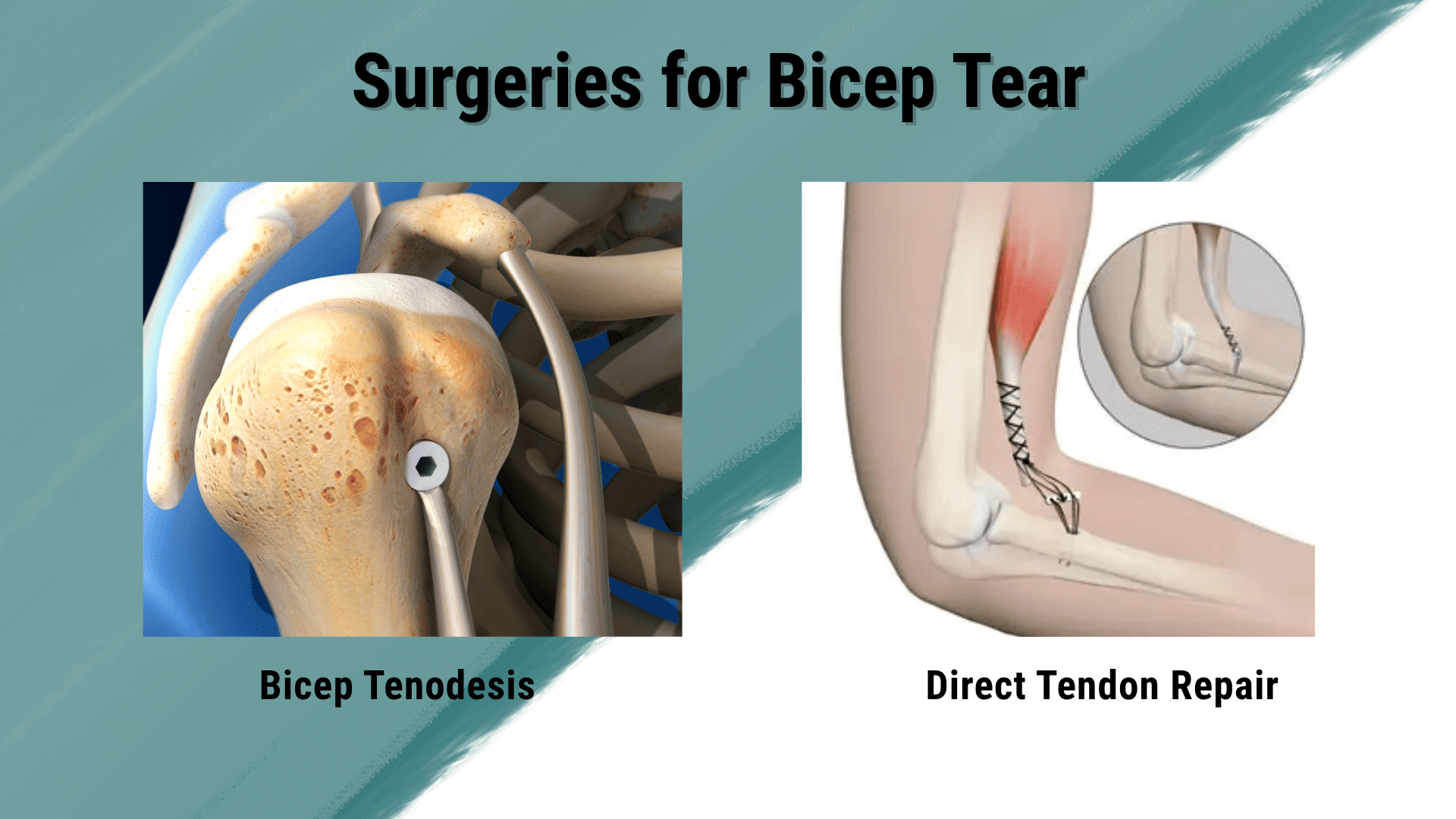A sudden pop in your upper arm followed by sharp pain can stop you mid-workout.
These could be symptoms of a bicep tear that require attention.
Knowing the symptoms of a bicep tear helps you determine when to seek medical care.
It also shows you what treatment options work best for your situation.
You’ll learn what a bicep rip is and how to spot the warning signs.
We’ll cover why these injuries happen and what treatment paths are available.
From rest and therapy to surgical repair, you’ll know what to expect.
What is a Bicep Tear?
Your bicep muscle sits in the front of your upper arm. It helps you bend your elbow and rotate your forearm. Strong cords of tissue called tendons connect this muscle to your bones.
A bicep tear happens when one of these tendons gets damaged or pulls away from the bone. Think of it like a rope that starts to fray or snap.
The bicep has three tendon attachment points. Two connect at your shoulder, the long head and the short head. One attaches to your elbow to a bone called the radius.
Most tears happen at the shoulder. About 90% occur there. The long head tendon is the most vulnerable spot.
Tears come in two types:
- Partial tear – The tendon is damaged or frayed but still attached
- Complete tear – The tendon fully separates from the bone
A complete tear is also referred to as a rupture. When this happens, your muscle can bunch up, creating a bulge in your upper arm. People often refer to this as a “Popeye muscle.”
Tears at the elbow are less common. They affect only 3 to 5 people per 100,000 each year. However, when they do occur, they typically cause more weakness than shoulder tears.
Symptoms of a Bicep Tear
Recognizing bicep tendon tear symptoms early helps you receive the right treatment more quickly. The signs can be sudden and obvious, or they might develop slowly over time.
Here are the most common signs to watch for:
- Sudden pop or snap – Many people hear a popping sound when the tendon tears, often during activities such as lifting or pulling something heavy.
- Sharp pain – Intense pain hits your upper arm near the shoulder or elbow. It may ease up after a week or two.
- Visible bulge – A complete tear causes the muscle to bunch up, creating a bulge that looks like Popeye’s muscle. You might notice a gap closer to your shoulder.
- Bruising and swelling – Dark bruises often appear within hours and can spread from your upper arm down to your elbow.
- Arm weakness – Your arm feels weaker, especially when bending your elbow. Simple tasks like lifting grocery bags become difficult.
- Difficulty with rotation: Turning your palm up becomes hard or painful. You need this motion for tasks like turning a doorknob.
Causes and Risk Factors of a Bicep Tear
Bicep tears don’t just happen out of nowhere. They usually result from specific injuries or develop over time due to the natural wear and tear of the body.
Knowing what puts you at risk can help you protect yourself.
| Cause/Risk Factor | How It Leads to Bicep Tears |
|---|---|
| Sudden injury | Lifting too heavy or falling on an outstretched arm puts sudden force on the tendon. |
| Overuse and repetitive motion | Constant overhead movements wear down tendons. Athletes like baseball players, swimmers, and weightlifters face a higher risk. |
| Age over 30 | Tendons weaken and fray as you age. Risk increases each year, especially for men. |
| Smoking | Nicotine affects the quality of tendons and their healing ability. |
Recognizing these risk factors enables you to take proactive steps to protect your tendons and prevent injury.
Treatment Options for Bicep Tears
Your treatment path depends on the severity of your tear and the level of activity you require. Some tears heal with rest and therapy, while others need surgery.
Your doctor will consider your age, overall health, and lifestyle when recommending treatment.
Non-Surgical Treatment
Many bicep tears, especially at the shoulder, can heal without surgery. This approach works best for partial tears or for people who don’t need full arm strength.
- Rest and activity modification: Stop activities that cause pain or stress your arm. Avoid heavy lifting and overhead movements. Your doctor may recommend wearing a sling for a brief time.
- Ice therapy: Apply cold packs to reduce pain and swelling. Ice works best in the first few days after injury. Use it for 15-20 minutes at a time, several times a day.
- Pain medication: Over-the-counter drugs, such as ibuprofen or naproxen, help reduce both pain and inflammation. These are called NSAIDs.
- Physical therapy: Once pain decreases, therapy helps restore movement and strength. Your therapist will teach you exercises to strengthen the surrounding muscles.
Recovery period: Symptoms improve over several weeks to several months. You may be able to resume some activities earlier.
Surgical Treatment
Surgery becomes necessary for complete tears at the elbow or when you need full arm strength back. Athletes and people with physically demanding jobs often choose surgery.
When surgery is recommended:
- Complete tears at the elbow
- Young, active patients who need full strength
- People whose non-surgical treatment didn’t work
- Jobs requiring powerful gripping or rotation
Types of Bicep Surgery:
- Bicep tenodesis: Used for shoulder tears. The surgeon reattaches your torn tendon to your upper arm bone using a screw. Best done within the first few weeks.
- Direct tendon repair: Used for elbow tears. The surgeon reattaches the tendon to the radius bone. This must be done within 2-3 weeks of the injury for optimal results.
Recovery period: You’ll wear a sling for 2-4 weeks after surgery. Full recovery takes 4-6 months. Athletes may need longer before returning to their sport.
Prevention Strategies for a Bicep Tear
Preventing bicep pain due to rupture is easier than recovering from one. Simple changes to your daily routine and workout habits can protect your tendons.
Here are practical steps you can take to reduce your risk:
- Warm up properly: Spend 5-10 minutes doing light movements before exercise or heavy lifting. Dynamic stretching prepares your muscles better than static stretching.
- Use proper lifting technique: Keep loads close to your body and avoid jerking movements. Ask a trainer to check your form if unsure.
- Strengthen supporting muscles: Work your entire upper body, not just biceps. Include rows, shoulder presses, and planks in your routine.
- Avoid overuse: Rest for at least 48 hours before working the same muscle group again. Listen to your body and take breaks when you need them.
- Stretch after exercise: Cool down with gentle stretching. Hold each stretch for 15-30 seconds to maintain muscle flexibility.
Conclusion
A bicep tear can sideline you from work, sports, and daily activities.
But catching it early makes all the difference. Pay attention to warning signs, such as sudden pain, popping sounds, or unusual bulges in your arm.
Most people recover well with the right approach. Whether you choose rest and therapy or need surgery depends on your goals and lifestyle.
Talk openly with your doctor about what matters most to you.
If you’re experiencing persistent arm pain or weakness, don’t wait. Have it checked out by a medical professional who can guide you toward a recovery plan.











